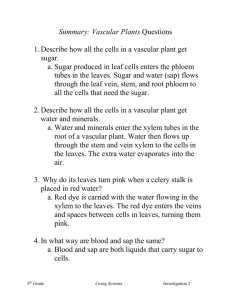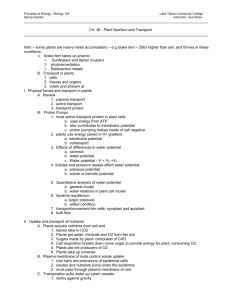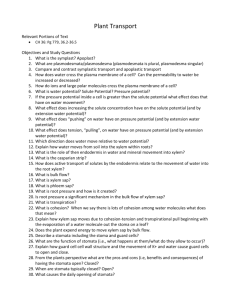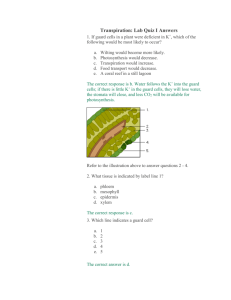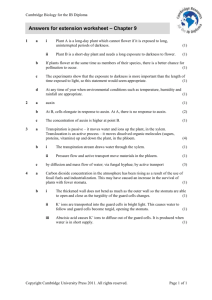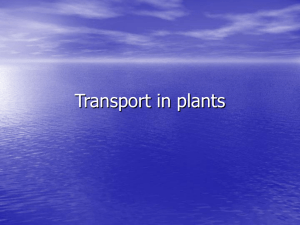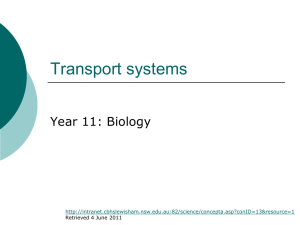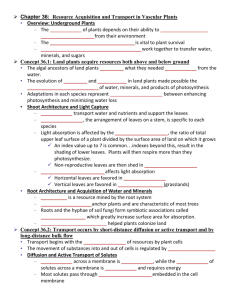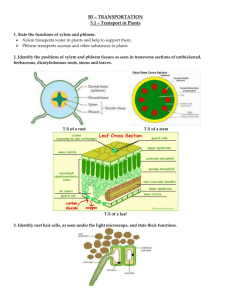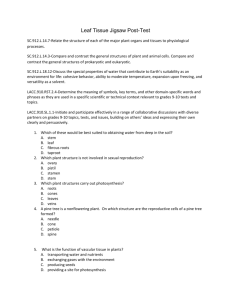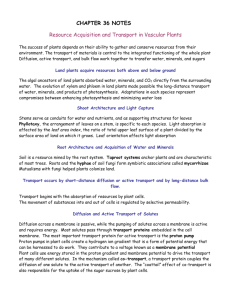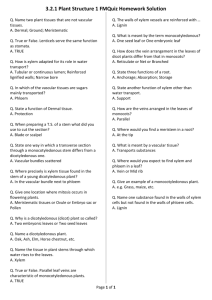CHAPTER 36: TRANSPORT IN PLANTS TERMS TO BE REVIEWED
advertisement
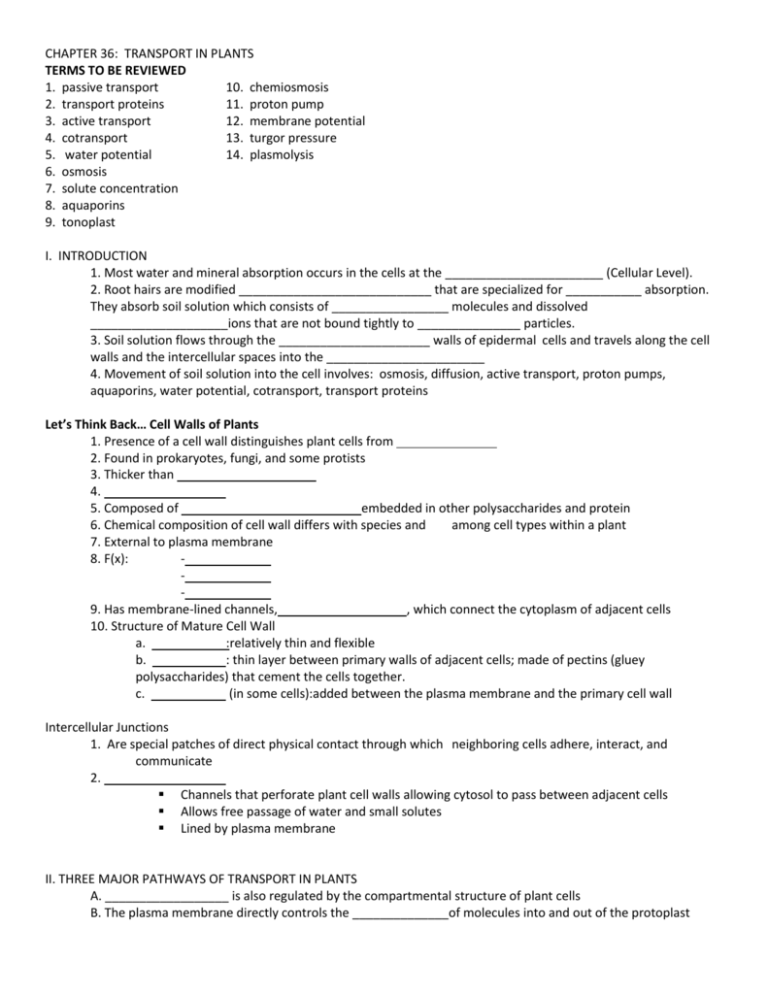
CHAPTER 36: TRANSPORT IN PLANTS TERMS TO BE REVIEWED 1. passive transport 10. chemiosmosis 2. transport proteins 11. proton pump 3. active transport 12. membrane potential 4. cotransport 13. turgor pressure 5. water potential 14. plasmolysis 6. osmosis 7. solute concentration 8. aquaporins 9. tonoplast I. INTRODUCTION 1. Most water and mineral absorption occurs in the cells at the _______________________ (Cellular Level). 2. Root hairs are modified ____________________________ that are specialized for ___________ absorption. They absorb soil solution which consists of _________________ molecules and dissolved ____________________ions that are not bound tightly to _______________ particles. 3. Soil solution flows through the ______________________ walls of epidermal cells and travels along the cell walls and the intercellular spaces into the _______________________ 4. Movement of soil solution into the cell involves: osmosis, diffusion, active transport, proton pumps, aquaporins, water potential, cotransport, transport proteins Let’s Think Back… Cell Walls of Plants 1. Presence of a cell wall distinguishes plant cells from 2. Found in prokaryotes, fungi, and some protists 3. Thicker than 4. 5. Composed of embedded in other polysaccharides and protein 6. Chemical composition of cell wall differs with species and among cell types within a plant 7. External to plasma membrane 8. F(x): 9. Has membrane-lined channels, , which connect the cytoplasm of adjacent cells 10. Structure of Mature Cell Wall a. :relatively thin and flexible b. : thin layer between primary walls of adjacent cells; made of pectins (gluey polysaccharides) that cement the cells together. c. (in some cells):added between the plasma membrane and the primary cell wall Intercellular Junctions 1. Are special patches of direct physical contact through which neighboring cells adhere, interact, and communicate 2. Channels that perforate plant cell walls allowing cytosol to pass between adjacent cells Allows free passage of water and small solutes Lined by plasma membrane II. THREE MAJOR PATHWAYS OF TRANSPORT IN PLANTS A. __________________ is also regulated by the compartmental structure of plant cells B. The plasma membrane directly controls the ______________of molecules into and out of the protoplast The _________________________ is a barrier between two major compartments, the _________________ and the __________________ C. The third major compartment in most mature plant cells is the _______________, a large organelle that occupies as much as ________________ or more of the protoplast’s volume The vacuolar membrane regulates transport between the _________________and the __________________ Cell Compartments: ___________________________________________________ D. In most plant tissues, the ________________ and ____________________are continuous from cell to cell The cytoplasmic continuum is called the __________________ The cytoplasm of neighboring cells is connected by channels called _______________________ The _______________________ is the continuum of cell walls and extracellular spaces III. ABSORPTION OF WATER AND MINERALS BY ROOTS 1. Pathway: _______________________________________________________________________________ 2. Mineral ions enter epidermal cells by __________________ and active transport using __________________ IV. TRANSPORT OF XYLEM SAP A. Ascent of xylem sap depends on: 1. _______________-the loss of water vapor from leaves and other aerial parts of the plant 2. ________________________________________-cohesion and adhesion B. ______________________ (composed of water and minerals) flows _______________ against gravity C. Xylem vessels are close to each ____________________ D. Water must move upward to replace that lost by _______________________ E. Pushing Xylem Sap: _______________________ 1. Usually occurs at ____________________ when transpiration is low 2. Root pressure (upward push of xylem sap) is generated by accumulation of ________________ in ___________________which lowers the water potential and forces fluid up the xylem 3. More water entering leaves than is transpired can result in ________________ (discharge of water droplets at the leaf margin) F. Pulling Xylem Sap: The Transpiration-Cohesion-Tension Mechanism 1. _______________________ in the airspaces of a leaf diffuses down its water potential gradient and exits the leaf via ___________________ by transpiration. 2. __________________________ produces negative pressure in the leaf, which exerts a pulling force on water in the xylem, pulling __________________ into the leaf 3. Involves: ____________________________________________ 4. _________________________—formation of water vapor pockets in xylem that breaks the chain of water molecules and the pull is stopped Once the _______________________ is broken the xylem vessels is no longer functional Can occur during __________________________________ 5. Ascent of xylem sap is ultimately solar powered. V. CONTROL OF TRANSPIRATION A. Introduction 1. About 95% of water taken in is lost by ___________________ through the stomata 2. Amount of water lost by a leaf depends on the number of _____________________ and the average size of the opening 3. _______________________, by controlling the size of stomata, help conserve water 4. Benefits of transpiration: a. Assists in _________________________ transfer from roots to shoots b. Reduces leaf _____________________________ 5. If transpiration exceeds delivery of water by xylem, plant _____________________ 6. Rate of transpiration is _______________________ on a sunny, warm, dry, and windy day 7. Stomata are more concentrated on ____________________of leaf away from the sun to reduce ______________ 8. Waxy ___________________ also prevents water loss B. How Stomata Open and Close 1. Guard Cells control stomatal ____________________ by changing shape. 2. When guard cells take in water, they become ____________________ and the gap between cells increases. 3. When guard cells lose water, they become ___________________ and the gap between cells decreases. 4. Changes in _____________pressure results primarily from the reversible uptake and loss of K+ by guard cells Stomata ____________—guard cells accumulate K+ and gain water Stomata ___________—guard cells lose K+ and lose water 5. Generally, stomata are opened during the ___________ and closed at ______________ 6. Stoma open at dawn because: _______________ stimulates guard cells to accumulate K+ and become turgid Decrease of _________________ because of PS _____________ of guard cells (circadian rhythms—cycles that have intervals of approximately 24 hours) 7. Stoma close during daytime because of: Water _____________________ (environmental stress) Production of ______________________ acid VI. TRANSPORT IN PHLOEM A. Introduction 1. ___________________—transport of organic products of PS by phloem throughout the plant -in angiosperms it involves sieve-tube members -direction varies 2. _____________________—aqueous solution that is mostly sucrose 3. __________________—an organ that is a net producer of sugar such as mature leaves 4. ____________________—an organ that is a net consumer or storer of sugar, such as a tuber or bulb B. Movement of phloem sap 1. Phloem sap moves from _____________________ 2. Direction of flow depends on location of ___________________ and sugar sink which depends on the season 3. Sugar is first loaded into sieve-tube members before moving to the sink. 4. Can involve: Symplastic and/or apoplastic routes Transfer cells—modified companion cells with structures which increase cells’ surface area and enhance transfer between apoplast and symplast Active transport and cotransport Loading of Sucrose into Phloem 5. Sugar will diffuse from ___________________ to the __________________ 6. Water follows by ____________________ C. Pressure Flow (Bulk Flow) of Phloem Sap in Angiosperms 1. Phloem sap moves by bulk flow driven by _______________________ (pressure flow) 2. _______________levels of sugar at the source lowers the water potential and causes water to flow into the tube 3. _________________ recycles the water from sink to source.
